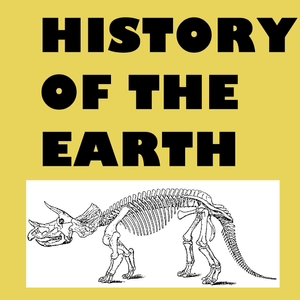
Episode 390 Mud Volcanoes
03/06/18 • -1 min
As the name implies, mud volcanoes are eruptions of mud – not molten rock as in igneous volcanoes. They’re found all around the world, amounting to about a thousand in total number known. The one thing they have in common is hot or at least warm water, so they occur in geothermal areas especially, but they also are found in the Arctic. They range in size from tiny, just a few meters across and high, to big things that can cover several square miles. In Azerbaijan some mud volcanoes reach 200 meters, 650 feet, in height, and around the world many of them do have conical, volcano-like shapes. But there are others that are just low mounds, more like a shield volcano.
A little (15-cm) mud volcano in New Zealand.
Photo by Richard Gibson. The mud is often enough just a slurry of suspended fine-grained sediment that mixes with the hot water. And by hot water, we don’t necessarily mean incredibly hot – mud volcano temperatures as cold as a couple degrees Centigrade are known, but most are associated with temperatures approaching the boiling point of water. In some places, like Yellowstone, the water is acidic which helps it dissolve rocks down to the tiny fragments in mud, and in other places it may just be the weathered soil and debris picked up by the water that makes the mud.
Mud volcanoes can erupt violently, or seep slowly, and emissions can last from minutes to years. I think it’s fair to think of some of them as geysers in which the water contains a lot of sediment, while others are more like thick, viscous muddy warm springs.
Besides water and fine sediment, mud volcanoes often contain natural gas – most commonly methane, but sometimes carbon dioxide, nitrogen, or other gases. The pressure of these gases is often the driving force behind eruptions, and with a hydrocarbon gas like methane present you might think mud volcanoes would be associated with oil and gas fields, and you’d be right. The hundreds of mud volcanoes in Azerbaijan and in the adjacent Caspian Sea are in the midst of the first great oil province to be exploited, and some of the petroleum deposits there are related to structures in the rocks and sediments caused by the upward force of the mud, which can bend its confining rocks as it rises, just as a salt dome can do. And since methane is flammable, often enough there are flames associated with mud volcanoes. In 2001, near Baku, Azerbaijan, flames shot 15 meters, near 50 feet, into the air. Gobustan in Azerbaijan is a World Heritage Site for its abundant rock carvings dating to 5000 to 20,000 years ago or more. The flaming methane eruptions of mud volcanoes in Azerbaijan have been linked to the development of the Zoroastrian religion, and in fact the name Azerbaijan derives from words meaning Land of the Eternal or Sacred Fire.
The most destructive mud volcano eruption in recent years was on the island of Java, in Indonesia, in May 2006. It erupted in the middle of a rice paddy, and ultimately killed 20 people, caused nearly 3 billion dollars in damage, and displaced 60,000 people. The mud it erupted covers about seven square kilometers, nearly three square miles, and in 2018 it continues to erupt something like 80,000 cubic meters of mud every day – that’s almost 3 million cubic feet, 32 Olympic swimming pools each day.
What caused the violent and extensive eruption of the Lusi Mud Volcano, also called the Sidoarjo mud flow, on Java is not clear. It may be simply part of the ongoing natural tectonic and magmatic processes in the region, which is dotted with many real volcanoes, the kind that carry molten rock to the surface as lava, and there’s a fault system that may provide a conduit for hot water from a volcano about 50 kilometers away. Lusi may be an entirely natural phenomenon. But there are also interesting possible trigger mechanisms. One suggests that a large earthquake two days before the mud volcano erupted changed the plumbing system enough to spur the eruption. That’s reasonable, since we know that earthquakes can have significant effects on geyser systems. Old Faithful in Yellowstone changed its eruption period following the strong Hebgen Lake earthquake in 1959. The other possible trigger is nearby drilling by a gas exploration company, which may have encountered an open pocket of gas or some other feature that ultimately may have allowed enough pressure to build up to make the mud volcano erupt. Good science on all sides of this issue have not resolved its origin with certainty, but on the whole I think the consensus is that the mud eruption was indeed triggered by the drilling. Studies continue, and there are legal cases in progress too, of course.
As the name implies, mud volcanoes are eruptions of mud – not molten rock as in igneous volcanoes. They’re found all around the world, amounting to about a thousand in total number known. The one thing they have in common is hot or at least warm water, so they occur in geothermal areas especially, but they also are found in the Arctic. They range in size from tiny, just a few meters across and high, to big things that can cover several square miles. In Azerbaijan some mud volcanoes reach 200 meters, 650 feet, in height, and around the world many of them do have conical, volcano-like shapes. But there are others that are just low mounds, more like a shield volcano.
A little (15-cm) mud volcano in New Zealand.
Photo by Richard Gibson. The mud is often enough just a slurry of suspended fine-grained sediment that mixes with the hot water. And by hot water, we don’t necessarily mean incredibly hot – mud volcano temperatures as cold as a couple degrees Centigrade are known, but most are associated with temperatures approaching the boiling point of water. In some places, like Yellowstone, the water is acidic which helps it dissolve rocks down to the tiny fragments in mud, and in other places it may just be the weathered soil and debris picked up by the water that makes the mud.
Mud volcanoes can erupt violently, or seep slowly, and emissions can last from minutes to years. I think it’s fair to think of some of them as geysers in which the water contains a lot of sediment, while others are more like thick, viscous muddy warm springs.
Besides water and fine sediment, mud volcanoes often contain natural gas – most commonly methane, but sometimes carbon dioxide, nitrogen, or other gases. The pressure of these gases is often the driving force behind eruptions, and with a hydrocarbon gas like methane present you might think mud volcanoes would be associated with oil and gas fields, and you’d be right. The hundreds of mud volcanoes in Azerbaijan and in the adjacent Caspian Sea are in the midst of the first great oil province to be exploited, and some of the petroleum deposits there are related to structures in the rocks and sediments caused by the upward force of the mud, which can bend its confining rocks as it rises, just as a salt dome can do. And since methane is flammable, often enough there are flames associated with mud volcanoes. In 2001, near Baku, Azerbaijan, flames shot 15 meters, near 50 feet, into the air. Gobustan in Azerbaijan is a World Heritage Site for its abundant rock carvings dating to 5000 to 20,000 years ago or more. The flaming methane eruptions of mud volcanoes in Azerbaijan have been linked to the development of the Zoroastrian religion, and in fact the name Azerbaijan derives from words meaning Land of the Eternal or Sacred Fire.
The most destructive mud volcano eruption in recent years was on the island of Java, in Indonesia, in May 2006. It erupted in the middle of a rice paddy, and ultimately killed 20 people, caused nearly 3 billion dollars in damage, and displaced 60,000 people. The mud it erupted covers about seven square kilometers, nearly three square miles, and in 2018 it continues to erupt something like 80,000 cubic meters of mud every day – that’s almost 3 million cubic feet, 32 Olympic swimming pools each day.
What caused the violent and extensive eruption of the Lusi Mud Volcano, also called the Sidoarjo mud flow, on Java is not clear. It may be simply part of the ongoing natural tectonic and magmatic processes in the region, which is dotted with many real volcanoes, the kind that carry molten rock to the surface as lava, and there’s a fault system that may provide a conduit for hot water from a volcano about 50 kilometers away. Lusi may be an entirely natural phenomenon. But there are also interesting possible trigger mechanisms. One suggests that a large earthquake two days before the mud volcano erupted changed the plumbing system enough to spur the eruption. That’s reasonable, since we know that earthquakes can have significant effects on geyser systems. Old Faithful in Yellowstone changed its eruption period following the strong Hebgen Lake earthquake in 1959. The other possible trigger is nearby drilling by a gas exploration company, which may have encountered an open pocket of gas or some other feature that ultimately may have allowed enough pressure to build up to make the mud volcano erupt. Good science on all sides of this issue have not resolved its origin with certainty, but on the whole I think the consensus is that the mud eruption was indeed triggered by the drilling. Studies continue, and there are legal cases in progress too, of course.
Previous Episode

Cretaceous and Cenozoic Vertebrates compilation
Smilodon and dire wolves (drawing by Robert Horsfall, 1913) Running time, 1 hour. File size, 69 megabytes.
This is an assembly of the episodes in the original series from 2014 that are about Cretaceous and Cenozoic vertebrates.
I’ve left the references to specific dates in the podcast so that you can, if you want, go to the specific blog post that has links and illustrations for that episode. They are all indexed on the right-hand side of the blog.
Thanks for your interest and support!
Next Episode

Episode 391 Valles Marineris
In today's episode we’re going to space. Specifically, Mars. You didn’t really think that earth science is really limited to the earth, did you? Our topic today will be the Valles Marineris.
The Valles Marineris is a long series of canyons east of Olympus Mons, the largest mountain in the solar system. These canyons are about 4,000 km long, 200 km wide and up to 7 km (23,000 ft) deep. On terrestrial scales, the Valles Marineris is as long as the distance from New York to Los Angeles. That’s about the same as Beijing to Hong Kong or Madrid to Copenhagen for our international listeners. They are as wide as central Florida, central Italy, or the middle of the Korean peninsula. Two and a half times deeper than Death Valley, though only about 60 percent of the depth of the Marianas Trench, the lowest point on earth.
Valles Marineris Image Courtesy NASA/JPL-Caltech
Not to be outdone, our planet, Earth, has even bigger valleys. These occur at the oceanic ridges, where plate spreading takes place. The longest rift valley on earth lies in the middle of the Mid-Atlantic Ridge, and it is more than double the length of the Valles Marineris. But let’s not belittle Mars. After all, while we have a pretty good idea for how oceanic rifts form on earth, there is quite a bit of debate about how Mars’ great valley formed. The most popular theory suggests that the Valles Marineris are an analog to our oceanic rifts, and formed by the same process. As the volcanoes of the nearby Tharsis region developed, the Martian crust bowed down toward the center of the planet due to the weight of the new volcanic rocks. In time, the crust began to crack. This crack is what we see in the Valles Marineris. Unlike on Earth, this rift valley did not continue expanding, but shut down as the Tharsis Region, and Mars as a whole, cooled. Remember that unlike Earth, Mars does not have plate tectonics. It doesn’t have a continual process of hot material (like lava) rising to the surface, while relatively cold material (like the oceanic crust) is brought down towards the planet’s center. More recent work has used satellite images, and high resolution elevation data to develop new insight into how the Valles Marineris formed. While images from the 1970’s Mariner 9 orbiter were quite blurry by today’s standards, new missions in the late 90’s to early 2000’s have given us a better view of the Martian surface than we have available for the earth. The Mars Reconnaissance Orbiter can take images where each pixel is about 0.5 m or 20 inches. That is, the color on each image is an average of an area of 0.25 square meters, or 2.5 square feet. It can then use image pairs to estimate the elevation of any point on the Martian surface with a pixel size of 0.25 m, or about 10 inches. These new satellite images include multispectral data, or images that look at different wavelengths of light. The camera on your phone works in the same way: There are sensors that pick up, red light, green light, and blue light. Your phone records the intensity of each color in each part of the image, and then plays it back on your phone’s screen to create a picture. Some of the satellites orbiting Mars take this to the next level. They don’t just take different slices of colored light, but also longer wavelength, infrared light. If you’ve ever seen an image from a thermal imaging camera, you know what this is. Parts of you show up as hotter or colder on the screen. It’s the same with the surface of the earth, or Mars. Scientists can compare the intensity of different wavelengths of light from each point on the surface. They can then compare these values, with what would be expected for different rock types. In other words, we’re able to roughly determine the types of rocks on the Martian surface without ever setting a boot, or rover tread, on the red planet. Data from these images has shown that the Valles Marineris have layered rock formations both on the sides of the canyons, and within them. The great valley has seen many landslides over the last 3.5 Billion years of its existence, as well as new and smaller canyons carved into it. Scientists now speculate that rather than just forming as a big crack in the Martian surface, the Valles Marineris have been sculpted by flowing water, either in its liquid form as rivers, or in its solid form as glaciers. An alternative hypothesis proposes that the Valles Marineris formed as a crack during a massive, planetary scale landslide. This landslide was about half t...
If you like this episode you’ll love
Episode Comments
Generate a badge
Get a badge for your website that links back to this episode
<a href="https://goodpods.com/podcasts/history-of-the-earth-6092/episode-390-mud-volcanoes-224896"> <img src="https://storage.googleapis.com/goodpods-images-bucket/badges/generic-badge-1.svg" alt="listen to episode 390 mud volcanoes on goodpods" style="width: 225px" /> </a>
Copy




